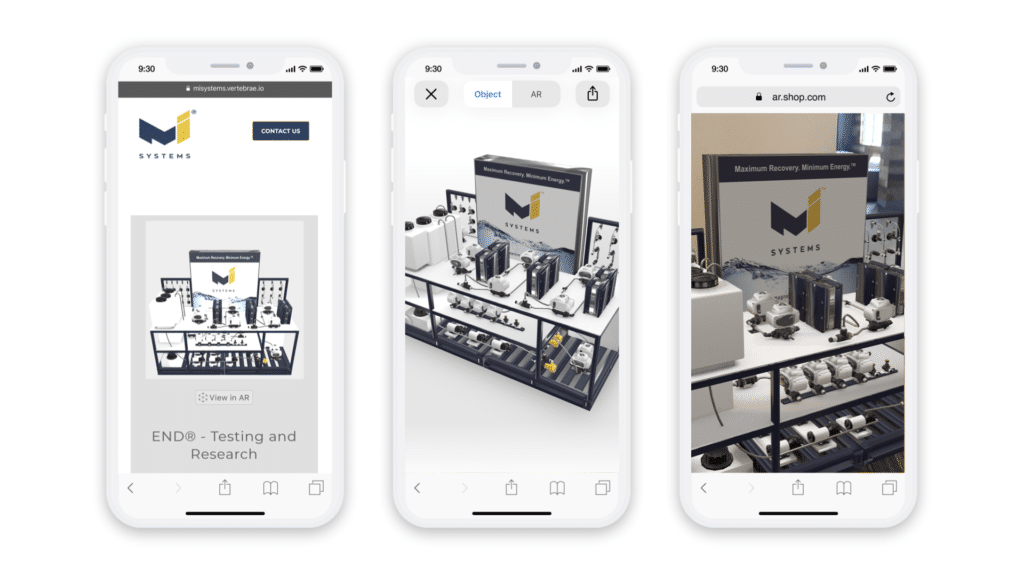B2B sales have evolved over the years, thanks to the increased efficiencies provided by advanced communication technology and enhanced product visualizations. Meanwhile, 3D and augmented reality (AR) are about to shift the paradigm for B2B commerce even more, especially in the case of complex or sizeable products. We’ve written before on the topic of AR and how large and small merchants are applying it to their own marketing and sales strategies to improve the buying journey. Enterprise sales comes with its own set of challenges different from those experienced by B2C sellers. Coming up, we’ll cover a few of the challenges B2B sellers face and how 3D and AR is setting new standards for B2B sales enablement.
To start, let’s talk about how 3D and AR are being used in B2B selling today. Similar to consumer-facing e-commerce implementations, enterprise sellers are creating virtual versions of their products and sharing them digitally. A great example of this is water technology company and Vertebrae partner, Magna Imperio Systems Corporation (MI Systems). A company on a mission to empower solutions to the worldwide clean water crisis, MI Systems is pioneering technology and services for business and civic use cases. Part of that solution includes industrial desalination systems that major corporations with processing plants can use to increase water efficiency by 98%. MI Systems recently partnered with us to create a 3D model of this system, with the option to place that model in augmented reality to equip salespeople with a portable version of their physical product.

But why did MI Systems prioritize 3D & AR for a system that seemingly sells itself? Let’s dive in to the challenges B2B sellers face today to find out.
Challenge 1: Communicating Value
In today’s crowded market, sellers more than ever before, must find ways to not only stand out but to demonstrate value. Beyond understanding the needs of a potential client, sellers must be able to convey how and why their product is a solution, and furthermore what differentiates it from competitor solutions. A complex story is in order – one that includes benefits, differentiation, and proof. The interactivity inherent in 3D & AR product visualizations leads to more productive conversations. By involving a prospect in a live demonstration of a virtual product as it is being explained, new insights may be uncovered. This can help facilitate more collaborative problem solving.
Challenge 2: Show, Rather than Tell
A picture is worth a thousand words, and an augmented reality experience is worth a thousand pictures. AR brings the product – no matter the size or complexity – to a prospect in a tangible way. It removes guesswork typically required by a prospect, making the features and value of the product immediately more digestible. Imagine bringing an industrial water filtration system to a tradeshow or onsite to a meeting. Size of a product is often a dealbreaker. And in many cases, the space required versus the space available to fit a product is not accurately understood. With augmented reality, a product can be placed true-to-size in real-time, which means size and fit can be demonstrated on the spot. Prospects are encouraged to try ownership before they buy on their terms and in their space.
Challenge 3: Highlight Customizable Solutions
AR gives sellers and prospects the ability to walk around a virtual product in real-time, pointing out features and details. For customizable products, this experience enables productive conversations about those customizable options. These conversations were previously limited by a prospect’s ability to imagine product features and the seller’s ability to convey them. This added efficiency allows for shorter sales cycles and less in-person visits to the prospect and the seller’s facilities.
Challenge 4: Carry the Message
In the case of B2B, the purchase decision is often not based on one person. Prospects need to be able to carry the message, relaying the information and value they’ve received to stakeholders. With AR, these prospects can literally carry the message to anyone involved in decision making via a simple link. This capability exponentially increases the number of people with access to a physical understanding of a product, increasing the likelihood of company-wide buy-in.
Because the B2B sales cycle can be quite long, accessibility to product information throughout the path to purchase is key. Even when physical product samples are portable, they can be misplaced or returned before they’ve reached the right people. Replacing a sample is significantly more complicated than re-sharing a link to a 3D product AR experience.
Summary: 3D & AR as B2B Sales Enablement = Success
Immersive product experiences made accessible via the web solve a multitude of B2B sales problems. From shortening the sales cycle to making your product more accessible, implementing 3D & AR is key. To find out more, schedule time to connect with a member of our team.
For a deeper dive into the results seen from one of our enterprise partners, check out the full MI Systems case study.
Not a current customer but ready to get started?
Demo the Platform Today!Already a current customer? Log in to Axis Today!

